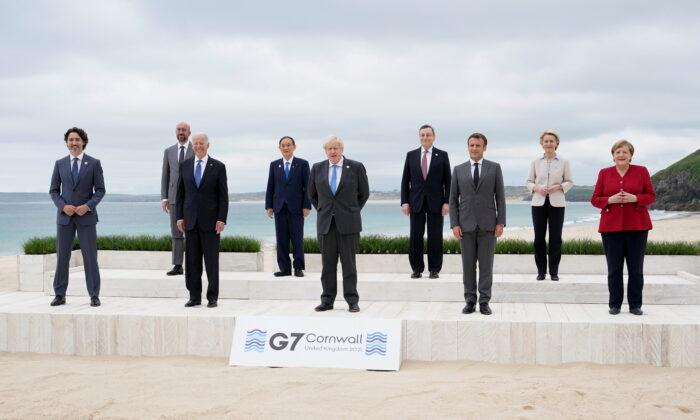CARBIS BAY, England–The Group of Seven (G-7) richest democracies on June 12 sought to counter China’s growing influence by offering developing nations an infrastructure plan that would rival Chinese leader Xi Jinping’s multi-trillion-dollar Belt and Road initiative.
The G-7, whose leaders are meeting in southwestern England, has been searching for a coherent response to the growing assertiveness of the Chinese Communist Party (CCP).
U.S. President Joe Biden and other G-7 leaders hope their plan, known as the Build Back Better World (B3W) initiative, will provide a transparent infrastructure partnership to help narrow the $40 trillion needed by developing nations by 2035, the White House said.
“This is not just about confronting or taking on China,” a senior official in Biden’s administration said. “But until now we haven’t offered a positive alternative that reflects our values, our standards, and our way of doing business.”
The G-7 and its allies will use the initiative to mobilize private-sector capital in areas such as climate, health and health security, digital technology, and gender equity and equality, the White House added.
It was not immediately clear how exactly the plan would work or how much capital it would ultimately allocate.
The Chinese regime’s Belt and Road Initiative (BRI) scheme, which Xi launched in 2013, involves development and investment initiatives that would stretch from Asia to Europe and beyond.
More than 100 countries have signed agreements with China to cooperate in BRI projects like railways, ports, highways, and other infrastructure.
Critics say Xi’s plan to create a trade route to link China with Asia, Europe, and beyond is a vehicle for the expansion of Communist China.
Leaders of the G-7—the United States, Canada, Britain, Germany, Italy, France, and Japan—want to use their gathering in the seaside resort of Carbis Bay to show the world that the richest democracies can offer an alternative to CCP’s growing clout.
The U.S. official said until now, the West had failed to offer a positive alternative to the “lack of transparency, poor environmental and labor standards, and coercive approach” of the Chinese regime that had left many countries worse off.
According to a Refinitiv database, as of mid-last year, more than 2,600 projects at a cost of $3.7 trillion were linked to the BRI, although the Chinese foreign ministry said last June that about 20 percent of projects had been seriously affected by the COVID-19 pandemic.
Criticism Over Camps
Biden made “forceful comments” to G-7 leaders about the need to make a strong statement on Washington and the use of forced labour in China, but there was a “spectrum of how far different countries are willing to go” in their criticism in a final communique from the three-day summit, another U.S. official said.The United States has pushed for specific language in the communique about forced labor in China’s Xinjiang region, officials said.
U.N. experts and rights groups estimate over one million people, mainly Uyghurs and other Muslim minorities, have been detained in recent years in a vast system of camps in Xinjiang.





